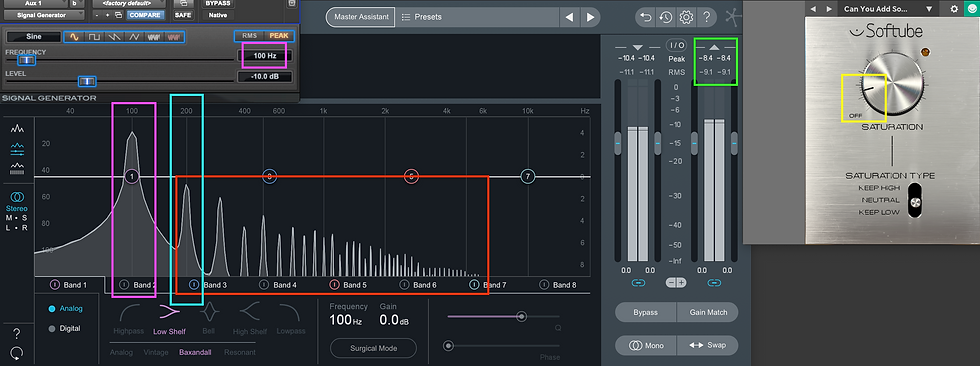ADD HARMONICS TO INPUTS OR MIXES WITH THE SOFTUBE SATURATION KNOB.

Indispensable for a fatter bass sound, more harmonics in the voice, that extra "grit" on the drums or even the entire mix, it's hard to believe that Saturation Knob is free.
Those who were students of the module 'Fundamentals' of the Enginear Audio Solutions' Audio Course, have already heard of Loudness Wars: A mere observation over the last 4 decades of music production where there was a stupid and ever growing spiral in Loudness values of commercial albums, where each artist wanted their music louder than the music of the "so-and-so". While the modernization of audio recording and its storage media has offered better signal-to-noise ratio and greater musical dynamic range, the pop/rock industry has gone the other way and every new release throughout the 80s, 90s and 2000 seemed to have an increasingly smaller dynamic range, which means less difference between the softer and louder parts of songs on an album. This is achieved primarily through the application of dynamic processing (compression and limiting) and one of the by-products of this process is distortion.
Saturation is one of the types of distortion, a phenomenon observed, for example, when a signal is amplified beyond the capabilities of the component or circuit that tries to amplify it and, in that way, the waveform of the signal in question is modified, it suffers a relative distortion to the original material. One of the symptoms of this process is the appearance of harmonics, sub-multiples of the original signal generated according to the nature of the component or circuit that distorts the signal. That's why the famous vacuum tubes still have a place in the audio world, because when they are overloaded and distorted, they often add even and low order harmonics (second, fourth, sixth...) to the original signal. Adding a second harmonic to a signal means adding a copy of that signal an octave higher in terms of musical notation/arrangement. The interval of an octave is one of the simplest in music, being the distance between a C (or any other note) and the next C on a piano, recalling a simple male-female duet or the interval that can be observed between the first two vocal notes of the classic song "Somewhere Over the Rainbow" from the movie "The Wizard of Oz". Imagine adding a little bit of this musical interval to anything that is distorted by a vacuum tube? For many styles it sounds interesting and pleasant, for sure. We can observe the effects of a saturation plugin very easily with the help of a spectrum analyzer in any DAW. In the example, below in Fig.2, a 100Hz sinusoidal signal (shown in pink) is generated by a signal generator and we can see its resulting spectrum free of relevant harmonics from that signal in the spectrum analyzer. Note the output level before saturation is added (in yellow):

Fig. 2: 100Hz sine wave, no saturation applied does not present relevant harmonics in the spectrum analyzer.
When we add a minimal amount of saturation (in yellow, in Fig.3) to the original signal, we see harmonics appearing in the spectrum (in red, in Fig.3) and a consequent increase in the output signal, ie: Saturation adds harmonics (in red, in Fig.3) and raises the output signal level (in green) making that mix more intelligible, noticeable or even more aggressive in a busy mix. Note those harmonics, highlighted in red, have multiple values of the fundamental signal (100Hz). The first harmonic is the fundamental frequency itself (in this case 100Hz) and the second harmonic is highlighted in blue: 200Hz. In this way, saturation is a great weapon for making basses, vocals, and drums cut a full mix with distorted guitars and synthesizers. It's the simple recipe for using the same resource that has become indispensable in guitars: Distortion and consequent harmonic enrichment.

Fig.3: The addition of saturation (in yellow), generates harmonics (in red) of the original signal (in pink) and raised the process output value (in green).
Perhaps it was for this reason that the sound of the Blues and, consequently, of Rock n' Roll emerged, as a result of the need for greater volumes on stage that found the power limitation of the circuits of the time: The result of this mixture was the distortion , something that defined the sound of pop/rock music for all subsequent generations. And since we never get enough of it, I'd like to share with each of you an excellent plugin that will allow you to add saturation and harmonics that are very welcome on basses, guitars, drums, vocals and even whole mixes: The Softube Saturation Knob.
The Saturation Knob can be downloaded for free at this link, but it's necessary to create an account on the Softube website and make the (free) purchase of the plugin on the manufacturer's website. The Saturation Knob has 3 saturation modes, "Keep Low" with an emphasis on low frequency saturation, "Keep High" with an emphasis on high frequencies and "Neutral", which seems to affect the entire spectrum equally. According to legendary Grammy winner Michael Brauer: " -My response when they told me the Saturation Knob is a free plug-in was — are you nuts? Seriously? It's too good to be free! I use it to make guitars fatter and more aggressive, snares naturally brighter, kicks punchier, vocals warmer. Basically, it's good on just about anything. Saturation Knob should be renamed Attitude Adjuster! If a plugin can be addicting, the Saturation Knob is it! "
Enjoyed this post? So, please, share and subscribe to our blog to be notified about future news! Follow us on Instagram, @enginearaudio and also subscribe to our YouTube channel for videos, tutorials, reviews and news: YouTube.com/EnginearAudio. See you next week!
From Jerusalem,
Tairo Arrabal
(Enginear Audio Solutions)


















Comentarios